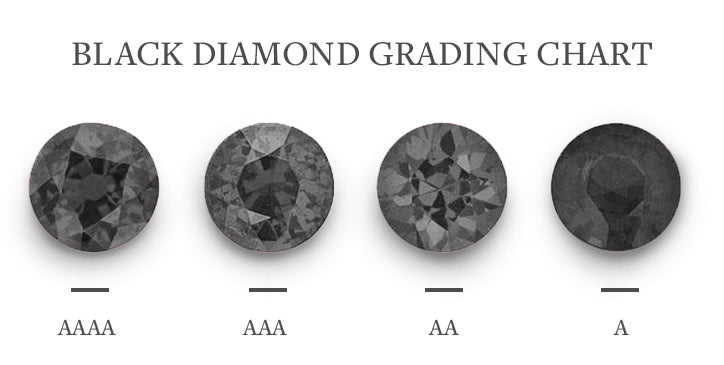How Much Is a Black Diamond Worth
You don't need a pair of skis to get properly acquainted with a black diamond. Though a popular term on the slopes, here we're focusing on black diamonds (otherwise known as carbonados) of the gemstone nature. Moreover, exploring the differences between lab grown black diamonds, and those of the naturally grown variety.
TABLE OF CONTENTS
Naturally Grown Fancy Black Diamonds: Origins & Price
Origins
Naturally grown black diamonds, while possible, are very rarely found in nature. In past instances, they've been found in Brazil, Central Africa, and other locations around the globe. Unlike other color diamonds that can attribute their color to geological impurities such as nitrogen, hydrogen, and boron, raw black diamonds owe their black color to the inclusion of graphite.
Price
Due to their scarcity, natural black diamonds are considered to be rarer than the traditional colorless diamond. In terms of pricing, natural fancy carbonados can cost anywhere from $3,000 to $5,000 a carat, obviously contingent upon size and among other factors.
Grading Black Diamonds
The 4C's (color, clarity, cut and, carat) are the standards to which colorless diamonds are graded, but because natural black diamonds are opaque in nature, they cannot be graded on this same GIA scale. Therefore, these dark gemstones are evaluated based on GIA's color grading system for colored diamonds.

Since there's little to no variation in saturation or tone of black diamond color, the term fancy black is used in carbonado grading. Moreover, the aforementioned term is used to distinguish whether or not the diamond is natural or lab-grown. For other diamond colors like pink for example, which can have varying opacities and hues, color is the most important grade when it comes to its value.
Natural carbonados are particularly difficult to cut and polish without chipping or breaking on the cutting wheel. This is due to the fact that they are polycrystalline, or aggregates of many individual diamond crystals. Because of this, they can take much longer to facet than colorless diamonds, and the finished gems are softer and more likely to take damage over time.
Lab Created and Treated Black Diamonds: Process & Price
Lab created black diamonds, and even natural diamonds that have undergone treatment, are considerably less expensive than those found naturally growing. Treated carbonados, which are usually naturally-mined colorless diamonds that have been treated to develop a black color, achieve their dark hue in one of two ways. The two processes are:
- Exposure to high heat
- Radiation using gamma rays in a nuclear reactor
Because many black diamonds are simply natural diamonds that have been treated to display a black color, they are easier to cut and shape versus their naturally grown counterparts. Lab grown carbonados are also significantly less expensive than their naturally found counterparts, going for as little as $200-$400 a carat.
Treated Black Diamonds: Process & Care
Just because a black diamond was found naturally growing, doesn't mean their quality can't be improved! Many carbonados that are sold for engagement rings or jewelry have been lab treated to enhance beauty and color. These diamonds begin as gray, heavily included and fractured, that is then subjected to a high-temperature/low-pressure treatment that graphitizes the fractures.
Care
As mentioned earlier, most black diamonds that are available for purchase on the market have been lab treated in one way or another, so it's helpful as a consumer to know your gemstone's origin story. This is especially true in regards to taking care of your diamond. The care and cleaning of carbonados is the same as for any delicate gemstone: do not use steam or ultrasonic cleaners, which could cause damage.
Note that a naturally grown black diamond, while praised for its hardness, is significantly softer than a colorless diamond. A black diamond's nature is such that it may contain hundreds if not thousands of microscopic fractures, which make it more vulnerable to breakage from sharp blows than colorless diamonds. In any case: it's a precious gemstone--be kind to it and handle with care.
What Determines The Price of a Black Diamond?
We don't expect you to know the difference between natural and lab grown black diamonds. Therefore, it's always better to ask a gemologist or trusted jeweler anytime you're thinking of making a new purchase. Price can vary based on finish, quality, size, carat weight, and whether or not the diamond sustained any lab treatment. All of these previously mentioned factors will be reflected on the price tag of your black diamond.
The price difference between lab-grown black diamond jewelry and naturally grown black diamond jewelry is significant. Therefore, it's very important for you to understand what you're paying for, and that you're making a smart purchase.
FAQs
What is a natural black diamond and what is a lab grown black diamond?
A natural black diamond occurs naturally in nature, and its body color can vary from near-colorless to brown or “olive” green. They get their black color due to the presence of graphite, hematite, or pyrite. Naturally occurring black diamonds are extremely rare and valuable.
Lab grown black diamonds are grown inside a laboratory under controlled conditions. They are made by either exposing a naturally mined colorless diamond to high heat or with radiation using gamma rays in a nuclear reactor.
Can black diamonds be created in all shapes?
Are black diamonds valuable?
How are black diamonds created?
How much does a 1 carat black diamond cost?










